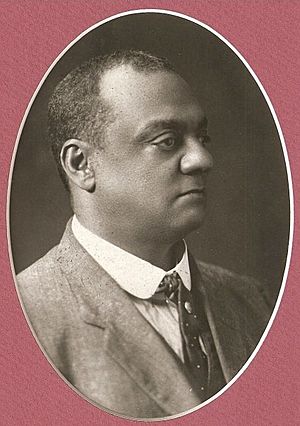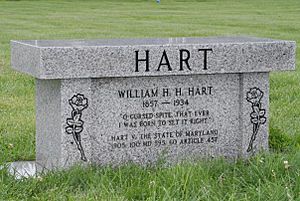William Henry Harrison Hart facts for kids
Quick facts for kids
William Henry Harrison Hart
|
|
|---|---|

Professor Hart
|
|
| Born | October 30, 1857 |
| Died | January 6, 1934 (aged 76) Brooklyn, New York, U.S.
|
| Resting place | National Harmony Memorial Park, Landover, Maryland |
| Education | Howard University (BA, MA, LLB) |
| Occupation | Professor, Lawyer, Activist, and Entrepreneur |
| Spouse(s) | Mary M. Olney |
| Children | William H. H. Hart Jr., Clementine Hart |
| Parent(s) | Henry Clay Hart, Jennie Dunn |
William Henry Harrison Hart (born October 30, 1857 – died January 6, 1934) was an African American lawyer and professor. He taught Criminal Law at Howard University from 1887 to 1922. He is famous for winning an important legal case called Hart v. State in 1905.
Contents
Early Life and Education
Hart was born in Eufaula, Alabama, on October 31, 1857. His father was Henry Clay Hart. William attended the American Missionary Association School in Eufaula from 1867 to 1874.
In 1874, during a time called the Reconstruction Era, some people tried to change the state government. Hart supported the Reconstruction efforts. Because of this, his life was threatened, and he had to leave Eufaula. He walked all the way to Washington, D.C..
When he arrived in Washington, D.C., Hart enrolled at Howard University in 1876. He first joined a program to prepare for college. He then earned his Bachelor of Arts (BA) degree in 1885. He continued his studies at the Howard University School of Law, getting his Bachelor of Laws (LLB) in 1887. He also earned a Master of Arts (MA) degree in 1889 and a Master of Laws (LLM) degree in 1891.
While studying law, he worked as a private secretary for Senator William M. Evarts. In 1895, he was allowed to practice law before the United States Supreme Court.
Career at Howard University
In 1890, Hart became a professor at Howard University's law school. He taught there for 25 years. He became an expert in different areas of law, including corporate law and criminal law.
Along with another law professor, William Henry Richards, Hart helped get $10,000 from Congress. This money was used to build the law school's first building.
Hart also worked for the U.S. Treasury and the United States Department of Agriculture. He was also the Assistant Librarian of Congress at the Library of Congress from 1893 to 1897. In 1889, Hart became the first black lawyer to be a special U.S. District Attorney for the District of Columbia.
Challenging Segregation Laws
In 1904, the state of Maryland passed a Jim Crow Law. This law required steamship lines and railroads to have separate facilities for different races. This meant that African-American passengers had to move to a "colored compartment" once a train crossed the Mason–Dixon line.
In the fall of 1904, William Henry Harrison Hart and his sister, Clementine Bartlett, were traveling. They refused to move to the "colored car." Hart was arrested and spent two days in jail. He was charged with breaking the separate car act and fined $50.
Hart immediately appealed this decision. He argued that the Jim Crow Law was against the U.S. Constitution. He also said it went against the Interstate Commerce Law, which deals with travel between states.
Hart took his case to a higher court. He argued that because he was traveling from New York to Washington (crossing state lines), the segregation laws should not apply to him. The court agreed with Hart on this point. They said that Maryland's Jim Crow Law could not apply to passengers traveling between states. This was a big victory for Hart and for civil rights.
Hart Farm School
In 1897, Hart started a school called the Hart Farm School and Junior Republic for Dependent Colored Boys. He bought 700 acres of land near Fort Washington, Maryland, for the school. The school could house up to 200 students.
Niagara Movement
On July 11, 1905, Hart joined 28 other important black thinkers, including W. E. B. DuBois. They founded the Niagara Movement. This group worked to fight for equal rights for African Americans. It was an important step that led to the creation of the NAACP in 1910.
Personal Life
In 1905, when he was 47, Hart married Mary M. Olney, who was 21. They lived in Washington D.C. Hart had a successful law practice there. William and Mary had three children: William H. H. Hart Jr., Clementine Hart, and one child who was stillborn. Many of Hart's family members still live in the Washington D.C. area today.
Death and Burial
William Henry Harrison Hart passed away in New York City on January 6, 1934. His body was brought to Washington, D.C., and he was first buried at Columbian Harmony Cemetery. Later, in 1959, when that cemetery closed, his remains were moved to National Harmony Memorial Park in Landover, Maryland.
Images for kids



